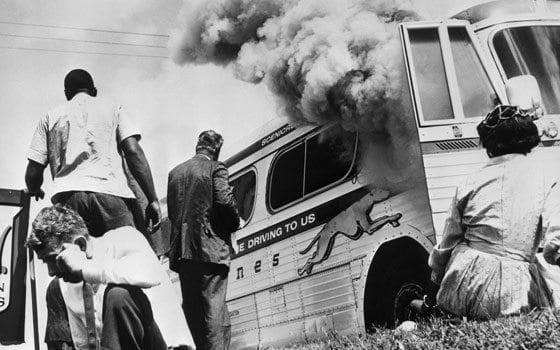

MONTGOMERY, Ala. — Freedom Riders who were attacked in Alabama’s capital city on May 20, 1961, returned 50 years later to be hailed as heroes and have a museum dedicated at the old bus station where they were confronted by an angry white mob.
U.S. Rep. John Lewis, D-Georgia, said he teared up Friday when he walked through the old Greyhound station where he was beaten and knocked unconscious.
“It says something about the distance we’ve come and the progress we’ve made in this state and nation,” said Lewis, who participated in the rides.
That change was evident in former Alabama Gov. John Patterson. In 1961, he called the Freedom Riders fools and agitators when they set out to integrate Southern bus stations. But the 89-year-old ex-governor welcomed them Friday and praised them for bringing needed changes.
“It took a lot of nerve and guts to do what they did,” Patterson said after meeting 10 Freedom Riders for the first time.
The Freedom Riders were mostly college students, blacks and whites, who set out on Greyhound and Trailways buses across the South to test a U.S. Supreme Court decision banning segregation in interstate transportation. That meant no more separate waiting rooms or water fountains designated for white and colored.
After one bus was firebombed near Anniston and the Ku Klux Klan threatened and beat Freedom Riders in Birmingham, U.S. Attorney General Robert Kennedy secured a promise from Patterson to have state troopers protect the group’s bus from Birmingham to Montgomery. City police were supposed to take up the job once they crossed the city line.
Patterson kept his word, with state trooper cars and a helicopter guarding the bus. Lewis said they were so well-protected that some slept on the bus.
But when they reached Montgomery’s Greyhound station, police were not there. Instead, an angry crowd fueled by Klansmen beat them, journalists and a Justice Department official — John Seigenthaler, later a well-known newspaper editor — after he came to the riders’ aid.
Freedom Rider Catherine Burks-Brooks of Birmingham, now 71, said one scene will stay with her forever, revealing the depth of hatred on their attackers’ faces and in their words.
“To see the expressions on white women’s faces screaming, ‘Kill the niggers. Kill the niggers.’ That sticks with me,” she said.
Freedom Rider Jim Zwerg, 71, of Tucson, Ariz., was beaten unconscious and ended up in the hospital, unable to complete the ride.
He said when he left Fisk University in Nashville to participate he had no idea of the many dangers they faced or that they would ride into history. He said the Freedom Riders were concerned about big issues, such as maintaining a policy of nonviolence no matter how hostile the foes, and little issues, such as how to pay for their bus tickets and what to do about the final exams they were missing in college.
He said he had some idea what he faced when he went to see a Fisk official about trying to make up his finals. “He said, ‘If you live through it, you can come back and take finals.’ ”
Montgomery was also the scene of another moment of high drama in the Freedom Riders’ journey.
The night after the bus station attacks, federal marshals and the National Guard had to be called in when an angry white mob surrounded the First Baptist Church, where riders and 1500 supporters including Martin Luther King Jr. had gathered. King pleaded with then-Attorney General Robert F. Kennedy to intervene, and he ultimately persuaded Patterson to send in the Guard.
The bus station attack prompted a court order against the Klan by U.S. District Judge Frank Johnson of Montgomery and led to new federal rules guaranteeing an end to segregation in all aspects of interstate travel.
Shortly after the museum opened Friday, an exhibit recognizing Johnson’s landmark rulings in the civil rights era was dedicated in the federal courthouse next door.
The old bus station was slated for demolition in 1993 to make way for an expansion of the courthouse. U.S. District Judge Myron Thompson and Patterson advocated that it be spared because of its place in history. After it sat empty for many years, the Alabama Historical Commission developed the 3,000-square-foot museum with art work, photos and descriptions of what happened and the impact it had.
“The museum may be small, but its significance is monumental,” Thompson said.
The Historical Commission is uncertain what days it will be open because the commission, like most other state agencies, is facing a 45 percent budget cut over two years.
The museum is within walking distance of several of Montgomery’s other civil rights attractions, including the Rosa Parks Library, the Civil Rights Memorial and Dexter Avenue King Memorial Baptist Church, where Martin Luther King served as pastor when he led the Montgomery Bus Boycott in 1955.
Thompson, Montgomery’s first black federal judge, praised the way the museum turned out, but he said, “There is no better way to forget something than to commemorate it.”
He said the museum should not be a symbol that everything the Freedom Riders sought has been accomplished. He said it should reinvigorate the Freedom Riders’ principles “of liberty and justice for all.”
He asked the crowd: “Would you today take a bus ride under the circumstances faced by the Freedom Riders back in 1961?”
Associated Press






